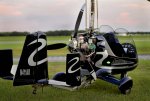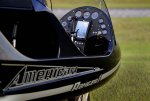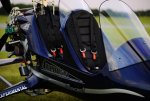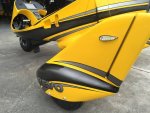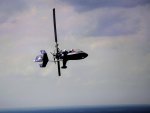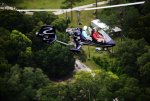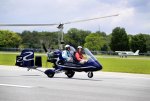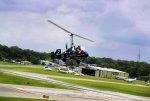CGameProgrammer
Member
After a lot of training in Air Gyro's Cavalon (39 hours) and MTO (13 hours), I went down to Zephyrhills and flew the prototype AR-1 a few times, training with Greg Spicola. I liked it and have placed my order but I thought I'd post my impressions of it here. (The only comparable gyro I've flown was the MTO.)
My very initial impressions, on the ground, were a bit disappointing. The wheel brake felt spongy with poor feedback and didn't seem to hold the brakes well even when applied pretty hard. The parking brake is a switch on the right side requiring two hands to use; your left hand holds the brake while the right activates the parking brake lock.
A push-pin is used to lock the cyclic; to remove it you have to hold the cyclic forward with one hand and use the other to extract the push-pin lock (which is kind of finicky) and then put it away somewhere, such as in the underseat bags. Those bags are pretty spacious though, and are easy to access while seated.
Pre-rotating takes a little while, probably just due to the heavy rotor blade, but it's not very long and Greg recommends starting it at the hold-short line to save time which makes sense. The cyclic-mounted manual engagement handle is easy to hold down.
After landing the rotor brake takes a full two minutes to bring the rotor to a stop, so you basically have to taxi it while managing the still-rotating blade.
But when flying it's just about perfect. Forward visibility is better than the MTO's because the instrument panel is lower down. In fact on the take-off roll I had the nose too high because of how different the sight picture is. But there is still plenty of room on the panel despite this. Attached is a picture of a production unit with a full-sized printout of the 10" Dynon Skyview display, radio, and intercom taped on. You can see there is plenty of room.
The control pressure on the cyclic was really light. I literally never used any trim at all, except once at the end just to verify that it had one. But the cyclic was very easy to manage at any speed, in contrast to the Cavalon or MTO which had very high pressure if you didn't get the trim just right. The AR-1 also turned very smoothly and sharply, feeling much more sporty than the MTO, although I only flew the MTO 4500' higher so it might not be a fair comparison.
Landing was also very pleasant; it definitely wanted to float much more than the MTO due to the higher inertia of the blades, though again we were much lower in altitude too. And when the MTO touches down it's quite jarring, at least on my landings, but the AR-1 had a really good suspension that made my landings feel gentle even when I flared way too high, which I tended to do.
But Abid and crew are more than willing to incorporate feedback and improve the design, and most of my concerns have either already been improved in the extant production units or they will be addressed in the future, such as for mine which I've now ordered.
The wheel brakes were already improved and are a bit easier to activate, and they are going to be adding a locking pawl to it so you can lock the brake one-handed just like with the MTO/Cavalon, making run up more streamlined. The right-side parking brake lever will remain for actual parking use. (You're not supposed to use the temporary lock long-term and this is also true of the MTO/Cavalon/etc.)
I did not like the cyclic lock push-pin so I proposed a much simpler alternative which they accepted and will use in mine, and possibly others? Not sure if they mean to standardize it or not. Basically it's a simple solution to keep the cyclic in the forward position that would be very fast to engage or disengage and does not involve anything separate like that push-pin.
I'm not aware of a fix for the rotor brake, at least not yet. Right now it's gentle enough that the gyro can be flown safely even with it engaged, and in fact another student did exactly that accidentally, on his own machine. But on the ground you have to taxi while managing the spinning rotor which is a bit of a hassle especially if the winds are blowing strongly.
But that's my only remaining concern and it's a minor one. Otherwise they've done a great job and I can't wait to get mine.



My very initial impressions, on the ground, were a bit disappointing. The wheel brake felt spongy with poor feedback and didn't seem to hold the brakes well even when applied pretty hard. The parking brake is a switch on the right side requiring two hands to use; your left hand holds the brake while the right activates the parking brake lock.
A push-pin is used to lock the cyclic; to remove it you have to hold the cyclic forward with one hand and use the other to extract the push-pin lock (which is kind of finicky) and then put it away somewhere, such as in the underseat bags. Those bags are pretty spacious though, and are easy to access while seated.
Pre-rotating takes a little while, probably just due to the heavy rotor blade, but it's not very long and Greg recommends starting it at the hold-short line to save time which makes sense. The cyclic-mounted manual engagement handle is easy to hold down.
After landing the rotor brake takes a full two minutes to bring the rotor to a stop, so you basically have to taxi it while managing the still-rotating blade.
But when flying it's just about perfect. Forward visibility is better than the MTO's because the instrument panel is lower down. In fact on the take-off roll I had the nose too high because of how different the sight picture is. But there is still plenty of room on the panel despite this. Attached is a picture of a production unit with a full-sized printout of the 10" Dynon Skyview display, radio, and intercom taped on. You can see there is plenty of room.
The control pressure on the cyclic was really light. I literally never used any trim at all, except once at the end just to verify that it had one. But the cyclic was very easy to manage at any speed, in contrast to the Cavalon or MTO which had very high pressure if you didn't get the trim just right. The AR-1 also turned very smoothly and sharply, feeling much more sporty than the MTO, although I only flew the MTO 4500' higher so it might not be a fair comparison.
Landing was also very pleasant; it definitely wanted to float much more than the MTO due to the higher inertia of the blades, though again we were much lower in altitude too. And when the MTO touches down it's quite jarring, at least on my landings, but the AR-1 had a really good suspension that made my landings feel gentle even when I flared way too high, which I tended to do.
But Abid and crew are more than willing to incorporate feedback and improve the design, and most of my concerns have either already been improved in the extant production units or they will be addressed in the future, such as for mine which I've now ordered.
The wheel brakes were already improved and are a bit easier to activate, and they are going to be adding a locking pawl to it so you can lock the brake one-handed just like with the MTO/Cavalon, making run up more streamlined. The right-side parking brake lever will remain for actual parking use. (You're not supposed to use the temporary lock long-term and this is also true of the MTO/Cavalon/etc.)
I did not like the cyclic lock push-pin so I proposed a much simpler alternative which they accepted and will use in mine, and possibly others? Not sure if they mean to standardize it or not. Basically it's a simple solution to keep the cyclic in the forward position that would be very fast to engage or disengage and does not involve anything separate like that push-pin.
I'm not aware of a fix for the rotor brake, at least not yet. Right now it's gentle enough that the gyro can be flown safely even with it engaged, and in fact another student did exactly that accidentally, on his own machine. But on the ground you have to taxi while managing the spinning rotor which is a bit of a hassle especially if the winds are blowing strongly.
But that's my only remaining concern and it's a minor one. Otherwise they've done a great job and I can't wait to get mine.




